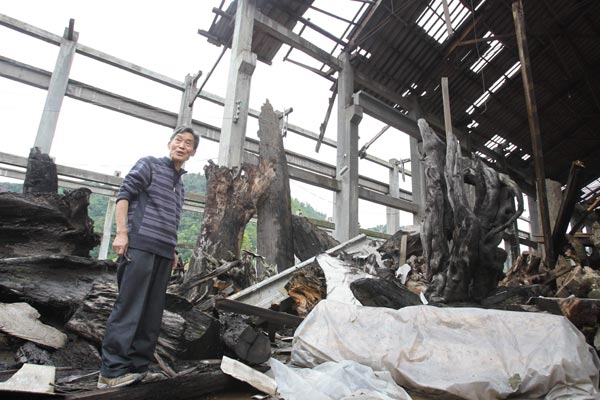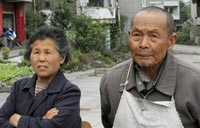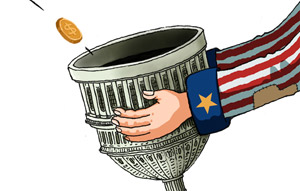Going back to root causes
Updated: 2013-06-13 10:02
By Deng Zhangyu (China Daily)
|
||||||||
 |
|
Liu Dazhong, 70, Liu Yiheng's father, visits the ruins of the family's root carving factory. |
 |
|
 |
He says a piece of quality wood can produce from one to several carvings depending on the size and shape.
Not far away from Wang's shop is one of the biggest root carving factories in Lushan - Daziran.
The factory's four-storey exhibition hall built along a river is on the verge of collapsing. Ruined root carvings were scattered everywhere.
Owner Liu Yiheng had learnt to carve from his father while still a teenager. It is a family business and he is now the fourth generation.
"Lushan is known for its root carving arts and crafts. The revenue from the whole industry reached 1 billion yuan last year," says Liu, who is also the chairman of the Root Carving Association of Lushan.
The art of carving dates back to the Eastern Han Dynasty (AD 25-220). At that time, the material used was mainly stone, but due to the rich store of rare ebony buried underground and in the rivers in Sichuan province, people turned to root carving. In recent years, the rareness of the wood and the excellence of the craftsmanship led to increased popularity for Lushan ebony carvings.
Liu's factory has more than 80 workers, among whom less than 20 are skilled craftsmen. Now most of them have returned home to rebuild their houses and only those living nearby stayed to help repair the factory.
"A penholder was priced at 30,000 yuan. Now it's broken. After we repair it, it will cost less than 10,000 yuan," says Liu.
The penholder he was referring to is made with the most precious of the ebonies - jinsi nanmu, also called golden thread wood for its fine golden grain. It is always in much demand.
Luo Zhirong is dedicated to searching out hidden and buried pieces of jinsi nanmu. She says the precious woods are frequently found in paddy fields and deep riverbeds. But it is the rare day when one can find a good specimen.
"If we are lucky to find one, we can sell it for half a million yuan," says Luo, standing besides her temporary tent. Her house at the county center is too damaged to live in.
 Luo says the quake stopped her search. She has no house to live in, so for the next months at least, building a new house is on top of her agenda.
Luo says the quake stopped her search. She has no house to live in, so for the next months at least, building a new house is on top of her agenda.
Along the street where 230 root carving shops congregate, only a few shops have opened for business, even though they are still pretty much in shambles.
"We may have to wait for at least half a year or even one year for full recovery, but we must face disaster with confidence," says Liu Yiheng, the owner of Daziran. Both of his two factories were significantly damaged, but he decided to stay open for business.
"Opening my shop is to send out a message of confidence to others," says Liu.

 Victoria Beckham S/S 2014 presented during NYFW
Victoria Beckham S/S 2014 presented during NYFW
 'Despicable' minions upset Depp's 'Lone Ranger' at box office
'Despicable' minions upset Depp's 'Lone Ranger' at box office
 'Taken 2' grabs movie box office crown
'Taken 2' grabs movie box office crown
 Rihanna's 'Diamonds' tops UK pop chart
Rihanna's 'Diamonds' tops UK pop chart
 Fans get look at vintage Rolling Stones
Fans get look at vintage Rolling Stones
 Celebrities attend Power of Women event
Celebrities attend Power of Women event
 Ang Lee breaks 'every rule' to make unlikely new Life of Pi film
Ang Lee breaks 'every rule' to make unlikely new Life of Pi film
 Rihanna almost thrown out of nightclub
Rihanna almost thrown out of nightclub
Most Viewed
Editor's Picks

|

|

|

|

|

|
Today's Top News
Going green can make good money sense
Senate leader 'confident' fiscal crisis can be averted
China's Sept CPI rose 3.1%
No new findings over Arafat's death: official
Detained US citizen dies in Egypt
Investment week kicks off in Dallas
Chinese firm joins UK airport enterprise
Trending news across China
US Weekly

|

|







